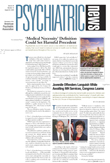It's a heart-wrenching yearning, searching for a deceased loved one, bittersweet recollections about that person, a conviction that to grieve less would be a betrayal of the beloved.
It is a riffling of papers for remnants of the deceased, a frantic listening for the person's footsteps on the stairwell....
“It” is unresolved or pathological grief—so-called traumatic grief—and a phenomenon mostly studied in adults who have lost their spouses.
But can adolescents, teenagers, and young adults also experience traumatic grief? It appears that they can, a study in the August American Journal of Psychiatry suggests. The study was headed by Nadine Melhem, Ph.D., an assistant professor of psychiatry at the University of Pittsburgh.
“This study is the first that we are aware of to look at traumatic grief among adolescents,” Melhem and her colleagues wrote.
The study included 130 friends and acquaintances of 26 suicide victims. The friends and acquaintances were identified in the Pittsburgh area between 1988 and 1991. They ranged in age from 11 to 23 years, with an average age of 18. The subjects were interviewed around six months, one to 1.5 years, and three years after the suicides that impacted their lives.
The instruments used to assess the subjects for traumatic grief were the Texas Revised Inventory of Grief and the Inventory of Complicated Grief. The former is a 21-item scale designed to measure the extent of traumatic grief. It asks subjects to indicate whether certain statements—for example,“ I get upset when I think about him or her” or “An unusual numbness comes over me when I think of him or her”—pertain to them. The latter, a 19-item scale, is the most widely used instrument to assess traumatic grief and is thought to discriminate better between traumatic grief and normal grief than does the former.
Of the 130 subjects studied, 29 experienced traumatic grief at six months, five at one year to 1.5 years, and nine at three years, the investigators found. This finding thus demonstrated that traumatic grief can occur in adolescents, teens, and young adults.
The investigators also determined how many of the subjects experienced major depression at six months, one to 1.5 years, and three years—the numbers were 38, 17, and 26, respectively. The number of subjects who experienced posttraumatic stress disorder at the three time intervals was three, three, and four, respectively.
The researchers also found that traumatic grief was independent of depression. Moreover, depressed and nondepressed subjects were equally likely to develop traumatic grief, and traumatic grief and posttraumatic stress disorder did not always overlap in the same subjects. Thus, traumatic grief appears to be distinct from depression and posttraumatic stress disorder in young people.
Still another interesting finding that emerged from the study is that traumatic grief in young people appears to predict the onset of depression or posttraumatic stress disorder.
“Traumatic grief is an underrecognized condition that occurs in adults of all ages, and in adolescents and children, following the death of a close friend or relative,” Katherine Shear, M.D., a professor of psychiatry at the University of Pittsburgh and one of the study authors, said in an interview. “This condition bears some resemblance to major depression and some to posttraumatic stress disorder but is different from each of these DSM-IV conditions. In adults, we have found traumatic grief to be a chronic, persistent condition associated with a great deal of psychological pain and functional impairment. There is some evidence that it predicts physical health problems as well. In both adolescents and adults, traumatic grief has been associated with increased suicidality.”
“This is a very important study in this new area of research,” Randall Marshall, M.D., director of trauma studies at New York State Psychiatric Institute, told Psychiatric News, “because it uses a rigorous, longitudinal design to clarify several important and controversial questions about the validity of traumatic grief, about traumatic grief in adolescents specifically, and about the natural course of the disorder in relation to major depression and posttraumatic stress disorder. The study offers more confirmation that the proposed nosological distinction between grief, posttraumatic stress disorder, and major depressive disorder is valid.”
“Dr. Katherine Shear has led the development and research of a much-needed, promising new psychosocial intervention for the treatment of traumatic grief, and results of her treatment study should soon be available,” Naomi Simon, M.D., associate director of the Center for Anxiety and Traumatic Stress Related Disorders at Massachusetts General Hospital, added. “Because of the very compelling findings in studies such as these, in collaboration with Dr. Shear, we have recently initiated the development of a clinical and research program of traumatic grief here at [our center].”
The study was funded by the National Institute of Mental Health.
Am J Psychiatry 2004 161 1411
